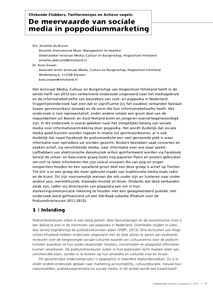© 2025 SURF
Beschrijving van inhoud en resultaat van het project 'Ageless jazz", waarin studenten concerten ontwikkelden voor ouderen in verzorgingshuizen.
DOCUMENT

This was the first time I attended a Pop and Jazz Platform meeting of the AEC. My involvement with AEC goes back for some time now. My first experience dates from 20 years ago, when I witnessed Yehudi Menuhin standing on a staircase addressing the delegates of the AEC Conference in Brussels. I think at that conference the number of delegates was lower than the 170 people that have been present these two days. The AEC has grown. The number of pop, jazz, world and folk music schools and departments has grown. Its importance within the sector has grown. And that shows in this meeting.
DOCUMENT

Paper presented on a congress in 1997 on fesival management. It gives a description of my very first econometric model on economic impacts of festivals.
DOCUMENT
Persbericht met daarin een verslag van de resultaten van een onderzoek gehouden op het jazzfestival in Den Bosch,2002.
DOCUMENT
This six-year study, consisting of four sub-investigations (one conceptual, three empirical), describes how subjectifying education with positioning of the body and embodiment of students in the educational practice requires teacher artistry, and forms by which teachers can stimulate learners' desire to become an embodied person in the world. The purpose of this research is to reconsider subjectification as the main target domain of education from the perspective of embodied cognition. The main research question is: How can Dutch teachers develop their artistry to create an inclusive educational practice that encourages their learners (in Dutch (v)mbo and higher education) to become embodied persons situated in the world? Since schools and classrooms are mini societies, there are many opportunities in these settings for learners' encounters with the world and their micro sociocultural worlds. Qualities like feeling what is happening inside oneself, expression of emotions, reflection and reflexivity, being able to be where the other is, having meaningful relationships with teachers and other learners, and engaging with the world are important for learners' wellbeing (De Haan, 2021; Zembylas, 2007; Zheng, 2022). The sort of curriculum that would pedagogically foster the development of these qualities in education is more likely to have the learner's body (or better, their embodied mind, Varela et al., 1992) at a central position in teaching and learning, thus enhancing opportunities for emotional and bodily expression (Zembylas, 2007). An overarching conclusion follows to answer the main research question. Teaching is not implementing a method or proven intervention 'that works' in the classroom, nor is it following a recipe (Biesta, in publication). It is both craft (technē) and art (including practical knowledge, phronesis) (Eisner, 2002). Through constant attention to embodied perception in the curriculum and evoking aesthetic experiences (Stenhouse, 1988), through 'making', working with 'experientiality' (Caracciolo, 2019) and 'doing the arts', giving shape to the environment (Alibali & Nathan, 2018), vitality, emotions, uncertainties and unpredictable activities and outcomes (Eisner, 1985), teachers develop their artistry. It is important for teachers to come together, add knowledge to each other and make education together. They have a responsibility to create inclusive spaces in the classroom for plurality and possible transformation. There are at least three current barriers in Dutch education that make it difficult for teachers to create inclusive spaces in the classroom: the Dutch 'measurement culture', the gap between academic "for the head" and vocational "for the hand" education, and Cartesian dualism as the paradigm underlying education. These three barriers do not disappear when teachers 'make' and 'do arts' with their learners' Artistic principles, however, in addition to recognizing the embodiment of learners, spark the joy of improvisation and experimentation and inspire teachers to further develop their teacher artistry. Schools then become spaces where teachers approach their learners as embodied persons who are in the world, rather than as individuals with separate brains, and bodies that are not being addressed. This is an important step toward embodied subjectification in education.
LINK
Paper for the Pop and Jazz Platform 2017 of the European Association of Conservatoires AEC, London, 18-2-2017
DOCUMENT

Het lectoraat Media, Cultuur en Burgerschap van Hogeschool Inholland heeft in de eerste helft van 2013 een verkennend onderzoek uitgevoerd naar het mediagebruik en de informatiebehoefte van bezoekers van rock- en poppodia in Nederland. Vragenlijstonderzoek laat zien dat er significante (zij het zwakke) verbanden bestaan tussen genrevoorkeur (smaak) en de vorm die hun informatiebehoefte heeft. Het onderzoek is niet representatief, onder andere omdat een groot deel van de respondenten uit Noord- en Zuid-Holland komt en jongeren oververtegenwoordigd zijn. In dit onderzoek is vooral gekeken naar het (mogelijke) belang van sociale media voor informatieverstrekking door poppodia. Het wordt duidelijk dat sociale media goed kunnen worden ingezet in relatie tot genrevoorkeuren, al is ook duidelijk dat naast Facebook de podiumwebsite een veel genoemde plek is waar informatie over optredens zal worden gezocht. Rockers bezoeken vaak concerten en zoeken actief, via verschillende media, naar informatie over wie waar speelt. Liefhebbers van elektronische dansmuziek willen geïnformeerd worden via Facebook terwijl de urban- en bass-scene graag (ook) nog papieren flyers en posters gebruiken om zich te laten informeren Het zijn vooral vrouwen die van pop en singersongwriters houden en een opvallend groot deel van deze groep is actief op Twitter. Tot slot is er een groep die meer gebruikt maakt van traditionele media zoals radio en de krant. Dit zijn voornamelijk mensen die iets ouder zijn en luisteren naar onder andere jazz, wereldmuziek, klassieke muziek en blues. Ondanks dat deze verbanden zwak zijn, raden wij directeuren van poppodia aan om in hun marketingcommunicatie rekening te houden met een gesegmenteerd publiek. Het onderzoek werd gefinancierd uit een SIA-Raak subsidie (Podium voor de Podiumdirecteuren 2011-2013).
DOCUMENT

Musical Video using techniques of Virtual Productions, depicting a NY metro and a jazz, with very complex filmming techniques.
LINK

Background: Given the demands posed by excessive practice quantities in modern dance, physical and mental health can be compromised. Therefore, there is a need to consider how quality of practice may be improved and possibly even reduce training times. Sports literature has shown that instructions and feedback given by coaches can have an effect on the quality of training and influence self-regulation and the performance of athletes. However, currently little is known about the use of instructions and feedback by dance teachers. The aim of the current study was, therefore, to examine the type of instructions and feedback given by dance teachers during various dance classes. Methods: A total of six dance teachers participated in this study. Video and audio recordings were made of six dance classes and two rehearsals at a contemporary dance university. The dance teacher’s coaching behavior was analyzed using the modified Coach Analysis and Intervention System (CAIS). Additionally, feedback and instructions were also examined in terms of their corresponding focus of attention. Absolute numbers, as well as times per minute (TPM) rates were calculated for each behavior before, during, and after an exercise. Absolute numbers were also used to calculate ratios of positive-negative feedback and open-closed questions. Results: Most feedback comments were given after an exercise (472 out of 986 total observed behaviors). Improvisation had the highest positive-negative feedback ratio (29) and open-closed questions ratio (1.56). Out of the focus of attention comments, internal focus of attention comments were used most frequently (572 out of 900). Discussion/conclusion: The results make clear that there is a large variability in instructions and feedback over teachers and classes. Overall, there is room for improvement toward a higher positive-negative feedback ratio, a higher open-closed question ratio and producing more comments eliciting an external focus of attention.
DOCUMENT


